Ethanol Dehydration to Ethylene over High-Energy Facets Exposed Gamma Alumina
Abstract
1. Introduction
2. Results and Discussion
2.1. Characterizations
2.1.1. Morphology and Textural Properties
2.1.2. Surface Properties
2.1.3. Acidity
2.2. Ethanol Dehydration
2.2.1. Catalytic Performance
2.2.2. Stability
2.2.3. Effect of Steam Treatment
3. Materials and Methods
3.1. Materials
3.2. Catalyst Synthesis
3.3. Characterizations
3.4. Catalytic Test
4. Conclusions
Supplementary Materials
Author Contributions
Funding
Conflicts of Interest
References
- Xiang, N.; Li, S.; Shu, C.; Xu, F. Dynamic material flow analysis of Chinese ethylene production processes and optimal pathway exploration with potential environmental-economic impacts. J. Clean. Prod. 2023, 392, 136282. [Google Scholar] [CrossRef]
- Zhao, Z.; Chong, K.; Jiang, J.; Wilson, K.; Zhang, X.; Wang, F. Low-carbon roadmap of chemical production: A case study of ethylene in China. Renew. Sustain. Energy Rev. 2018, 97, 580–591. [Google Scholar] [CrossRef]
- Walsh, B.; Ciais, P.; Janssens, I.a.; Peñuelas, J.; Riahi, K.; Rydzak, F.; van Vuuren, D.P.; Obersteiner, M. Pathways for balancing CO2 emissions and sinks. Nat. Commun. 2017, 8, 14856. [Google Scholar] [CrossRef]
- Silva, C.E.F.; Bertucco, A. Bioethanol from microalgae and cyanobacteria: A review and technological outlook. Process Biochem. 2016, 51, 1833–1842. [Google Scholar] [CrossRef]
- Handler, R.; Shonnard, D.R.; Griffing, E.; Lai, A.; Palou-Rivera, I. Life cycle assessments of ethanol production via gas fermentation: Anticipated greenhouse gas emissions for cellulosic and waste gas feedstocks. Ind. Eng. Chem. Res. 2015, 55, 3253–3261. [Google Scholar] [CrossRef]
- Qian, Q.; Cui, M.; He, Z.; Wu, C.; Zhu, Q.; Zhang, Z.; Ma, J.; Yang, G.; Zhang, J.; Han, B. Highly selective hydrogenation of CO2 into C2+ alcohols by homogeneous catalysis. Chem. Sci. 2015, 6, 5685–5689. [Google Scholar] [CrossRef] [PubMed]
- Luk, H.T.; Mondelli, C.; Ferré, D.C.; Stewart, J.A.; Pérez-Ramírez, J. Status and prospects in higher alcohols synthesis from syngas. Chem. Soc. Rev. 2017, 46, 1358–1426. [Google Scholar] [CrossRef]
- Liu, Y.; Murata, K.; Inaba, M.; Takahara, I. Synthesis of ethanol from methanol and syngas through an indirect route containing methanol dehydrogenation, DME carbonylation, and methyl acetate hydrogenolysis. Fuel Process. Technol. 2013, 110, 206–213. [Google Scholar] [CrossRef]
- Cao, K.; Fan, D.; Gao, M.; Fan, B.; Chen, N.; Wang, L.; Tian, P.; Liu, Z. Recognizing the important role of surface barriers in MOR zeolite catalyzed DME carbonylation reaction. ACS Catal. 2022, 12, 1–7. [Google Scholar] [CrossRef]
- Mohsenzadeh, A.; Zamani, A.; Taherzadeh, M.J. Bioethylene production from ethanol: A review and techno-economical evaluation. ChemBioEng Rev. 2017, 4, 75–91. [Google Scholar] [CrossRef]
- Zhang, M.; Yu, Y. Dehydration of ethanol to ethylene. Ind. Eng. Chem. Res. 2013, 52, 9505–9514. [Google Scholar] [CrossRef]
- Yakovleva, I.S.; Banzaraktsaeva, S.P.; Ovchinnikova, E.V.; Chumachenko, V.A.; Isupova, L.A. Catalytic dehydration of bioethanol to ethylene. Catal. Ind. 2016, 8, 152–167. [Google Scholar] [CrossRef]
- Phung, T.K.; Busca, G. Ethanol dehydration on silica-aluminas: Active sites and ethylene/diethyl ether selectivities. Catal. Commun. 2015, 68, 110–115. [Google Scholar] [CrossRef]
- Wannaborworn, M.; Praserthdam, P.; Jongsomjit, B. A comparative study of solvothermal and sol-gel-derived nanocrystalline alumina catalysts for ethanol dehydration. J. Nanomater. 2015, 519425. [Google Scholar] [CrossRef]
- Feng, R.; Yan, X.; Hu, X. Effects of boron and fluorine modified γ-Al2O3 with tailored surface acidity on catalytic ethanol dehydration to ethylene. J. Porous Mater. 2018, 25, 1105–1114. [Google Scholar] [CrossRef]
- Janlamool, J.; Jongsomjit, B. Catalytic ethanol dehydration to ethylene over nanocrystalline χ- and γ-Al2O3 Catalysts. J. Oleo Sci. 2017, 66, 1029–1039. [Google Scholar] [CrossRef]
- Shetsiri, S.; Thivasasith, A.; Saenluang, K.; Wannapakdee, W.; Salakhum, S.; Wetchasat, P.; Nokbin, S.; Limtrakul, J.; Wattanakit, C. Sustainable production of ethylene from bioethanol over hierarchical ZSM-5 nanosheets. Sustain. Energy Fuels 2019, 3, 115–126. [Google Scholar] [CrossRef]
- Salem, H.M.; Mohamed, R.S.; Alkahlawy, A.A.; Gobara, H.M.; Hassan, A.E.A.; Hassan, S.A. Enhanced ethylene production by dehydration of ethanol over Al/SBA-15 mesoporous catalysts. J. Porous Mater. 2019, 26, 735–745. [Google Scholar] [CrossRef]
- Chen, B.; Lu, J.; Wu, L.; Chao, Z. Dehydration of bio-ethanol to ethylene over iron exchanged HZSM-5. Chin. J. Catal. 2016, 37, 1941–1948. [Google Scholar] [CrossRef]
- Austin, N.; Kostetskyy, P.; Mpourmpakis, G. Design of highly selective ethanol dehydration nanocatalysts for ethylene production. Nanoscale 2018, 10, 4004–4009. [Google Scholar] [CrossRef]
- Xia, W.; Wang, F.; Wang, L.; Wang, J.; Mu, X.; Chen, K. High performance SiO2-ZrO2 binary oxide for ethanol conversion to ethylene. Catal. Lett. 2018, 148, 3024–3034. [Google Scholar] [CrossRef]
- Xie, X.; Li, Z.; Li, B.; Wu, X.; An, X. Novel catalyst PTMA-PILC: Structural properties and catalytic performance for the dehydration of bioethanol to ethylene. RSC Adv. 2015, 5, 46316–46324. [Google Scholar] [CrossRef]
- Alharbi, W.; Brown, E.; Kozhevnikova, E.F.; Kozhevnikov, I.V. Dehydration of ethanol over heteropoly acid catalysts in the gas phase. J. Catal. 2014, 319, 174–181. [Google Scholar] [CrossRef]
- Chumachenko, V.A.; Ovchinnikova, E.V. Activities of industrial alumina based catalysts in the dehydration of ethanol to ethylene. Catal. Ind. 2016, 8, 134–138. [Google Scholar] [CrossRef]
- Chaichana, E.; Boonsinvarothai, N.; Chitpong, N.; Jongsomjit, B. Catalytic dehydration of ethanol to ethylene and diethyl ether over alumina catalysts containing different phases with boron modification. J. Porous Mater. 2019, 26, 599–610. [Google Scholar] [CrossRef]
- Phung, T.K.; Lagazzo, A.; Crespo, M.Á.R.; Escribano, V.S.; Busca, G. A study of commercial transition aluminas and of their catalytic activity in the dehydration of ethanol. J. Catal. 2014, 311, 102–113. [Google Scholar] [CrossRef]
- El-Nadjar, W.; Bonne, M.; Trela, E.; Rouleau, L.; Mino, A.; Hocine, S.; Payen, E.; Lancelot, C.; Lamonier, C.; Blanchard, P.; et al. Infrared investigation on surface properties of alumina obtained using recent templating routes. Microporous Mesoporous Mater. 2012, 158, 88–98. [Google Scholar] [CrossRef]
- Feng, R.; Hu, X.; Yan, X.; Yan, Z.; Rood, M.J. A high surface area mesoporous γ-Al2O3 with tailoring texture by glucose template for ethanol dehydration to ethylene. Microporous Mesoporous Mater. 2016, 241, 89–97. [Google Scholar] [CrossRef]
- Cai, W.; Zhang, S.; Lv, J.; Chen, J.; Yang, J.; Wang, Y.; Guo, X.; Peng, L.; Ding, W.; Chen, Y.; et al. Nanotubular gamma alumina with high-energy external surfaces: Synthesis and high performance for catalysis. ACS Catal. 2017, 7, 4083–4092. [Google Scholar] [CrossRef]
- Wang, Y.; Yang, J.; Gu, R.; Peng, L.; Guo, X.; Xue, N.; Zhu, Y.; Ding, W. Crystal-facet effect of γ-Al2O3 on supporting CrOx for catalytic semihydrogenation of acetylene. ACS Catal. 2018, 8, 6419–6425. [Google Scholar] [CrossRef]
- Cui, Y.; Liu, N.; Xia, Y.; Lv, J.; Zheng, S.; Xue, N.; Peng, L.; Guo, X.; Ding, W. Efficient self-metathesis of 1-butene on molybdenum oxide supported on silica modified one-dimensional γ-Al2O3. J. Mol. Catal. A-Chem. 2014, 394, 1–9. [Google Scholar] [CrossRef]
- Ballinger, T.H.; Yates, J.T. IR spectroscopic detection of Lewis acid sites on Al2O3 using adsorbed CO. Correlation with Al-OH group removal. Langmuir 1991, 7, 3041–3045. [Google Scholar] [CrossRef]
- Wang, X.; Wovchko, E.A. Infrared spectroscopic investigation of the surface reaction of phosphorus trifluoride on γ-alumina. Langmuir 2003, 19, 5295–5302. [Google Scholar] [CrossRef]
- Knözinger, H.; Ramasamy, P. Catalytic aluminas: Surface models and characterization of surface sites. Catal. Rev. Sci. Eng. 1978, 17, 31–70. [Google Scholar] [CrossRef]
- Morterra, C.; Magnacca, G. A case study: Surface chemistry and surface structure of catalytic aluminas, as studied by vibrational spectroscopy of adsorbed species. Catal. Today 1996, 27, 497–532. [Google Scholar] [CrossRef]
- Krokidis, X.; Raybaud, P.; Gobichon, A.; Rebours, B.; Euzen, P.; Toulhoat, H. Theoretical study of the dehydration process of boehmite to γ-alumina. J. Phys. Chem. B 2001, 105, 5121–5130. [Google Scholar] [CrossRef]
- Ciuparu, D.; Perkins, E.; Pfefferle, L. In situ DR-FTIR investigation of surface hydroxyls on γ-Al2O3 supported PdO catalysts during methane combustion. Appl. Catal. A Gen. 2004, 263, 145–153. [Google Scholar] [CrossRef]
- Digne, M.; Sautet, P.; Raybaud, P.; Euzen, P.; Toulhoat, H. Hydroxyl groups on γ-alumina surfaces: A DFT study. J. Catal. 2002, 211, 1–5. [Google Scholar] [CrossRef]
- Digne, M.; Sautet, P.; Raybaud, P.; Euzen, P.; Toulhoat, H. Use of DFT to achieve a rational understanding of acid-basic properties of γ-alumina surfaces. J. Catal. 2004, 226, 54–68. [Google Scholar] [CrossRef]
- Li, X.; Zhang, W.; Liu, S.; Xu, L.; Han, X.; Bao, X. The role of alumina in the supported Mo/HBeta-Al2O3 catalyst for olefin metathesis: A high-resolution solid-state NMR and electron microscopy study. J. Catal. 2007, 250, 55–66. [Google Scholar] [CrossRef]
- Gonzales, N.O.; Chakraborty, A.K.; Bell, A.T. A density functional theory study of hydrogen recombination and hydrogen-deuterium exchange on Ga/H-ZSM-5. Top. Catal. 1999, 9, 207–213. [Google Scholar] [CrossRef]
- Phung, T.; Hernández, L.P.; Lagazzo, A.; Busca, G. Dehydration of ethanol over zeolites, silica alumina and alumina: Lewis acidity, Brønsted acidity and confinement effects. Appl. Catal. A Gen. 2015, 493, 77–89. [Google Scholar] [CrossRef]
- Kwak, J.; Mei, D.; Peden, C.; Rousseau, R.; Szanyi, J. (100) facets of γ-Al2O3: The active surfaces for alcohol dehydration reactions. Catal. Lett. 2011, 141, 649–655. [Google Scholar] [CrossRef]
- Topchieva, K.V.; Yun-Pin, K.; Smirnova, I.V. 81 Function of surface compounds in the study of catalytic dehydration of alcohols over aluminum oxide and silica-alumina catalysts. Adv. Catal. 1957, 9, 799–806. [Google Scholar]
- DeWilde, J.F.; Chiang, H.; Hickman, D.A.; Ho, C.R.; Bhan, A. Kinetics and mechanism of ethanol dehydration on γ-Al2O3: The critical role of dimer inhibition. ACS Catal. 2013, 3, 798–807. [Google Scholar] [CrossRef]
- Kovarik, L.; Genc, A.; Wang, C.; Qiu, A.; Peden, C.H.F.; Szanyi, J.; Kwak, J.H. Tomography and high-resolution electron microscopy study of surfaces and porosity in a plate-like γ-Al2O3. J. Phys. Chem. C 2013, 117, 179–186. [Google Scholar] [CrossRef]
- DeWilde, J.F.; Czopinski, C.J.; Bhan, A. Ethanol dehydration and dehydrogenation on γ-Al2O3: Mechanism of acetaldehyde formation. ACS Catal. 2014, 4, 4425–4433. [Google Scholar] [CrossRef]
- Ali, S.; Abbas, Y.; Zuhra, Z.; Butler, I.S. Synthesis of γ-alumina (Al2O3) nanoparticles and their potential for use as an adsorbent in the removal of methylene blue dye from industrial wastewater. Nanoscale Adv. 2019, 1, 213–218. [Google Scholar] [CrossRef]
- Escribano, V.S.; Garbarino, G.; Finocchio, E.; Busca, G. γ-alumina and amorphous silica-alumina: Structural features, acid sites and the role of adsorbed water. Top. Catal. 2017, 60, 1554–1564. [Google Scholar] [CrossRef]
- Ding, W.; Li, S.; Meitzner, G.D.; Iglesia, E. Methane conversion to aromatics on Mo/H-ZSM5: Structure of molybdenum species in working catalysts. J. Phys. Chem. B 2001, 105, 506–513. [Google Scholar] [CrossRef]
- Xue, N.; Chen, X.; Nie, L.; Guo, X.; Ding, W.; Chen, Y.; Gu, M.; Xie, Z. Understanding the enhancement of catalytic performance for olefin cracking: Hydrothermally stable acids in P/HZSM-5. J. Catal. 2007, 248, 20–28. [Google Scholar] [CrossRef]

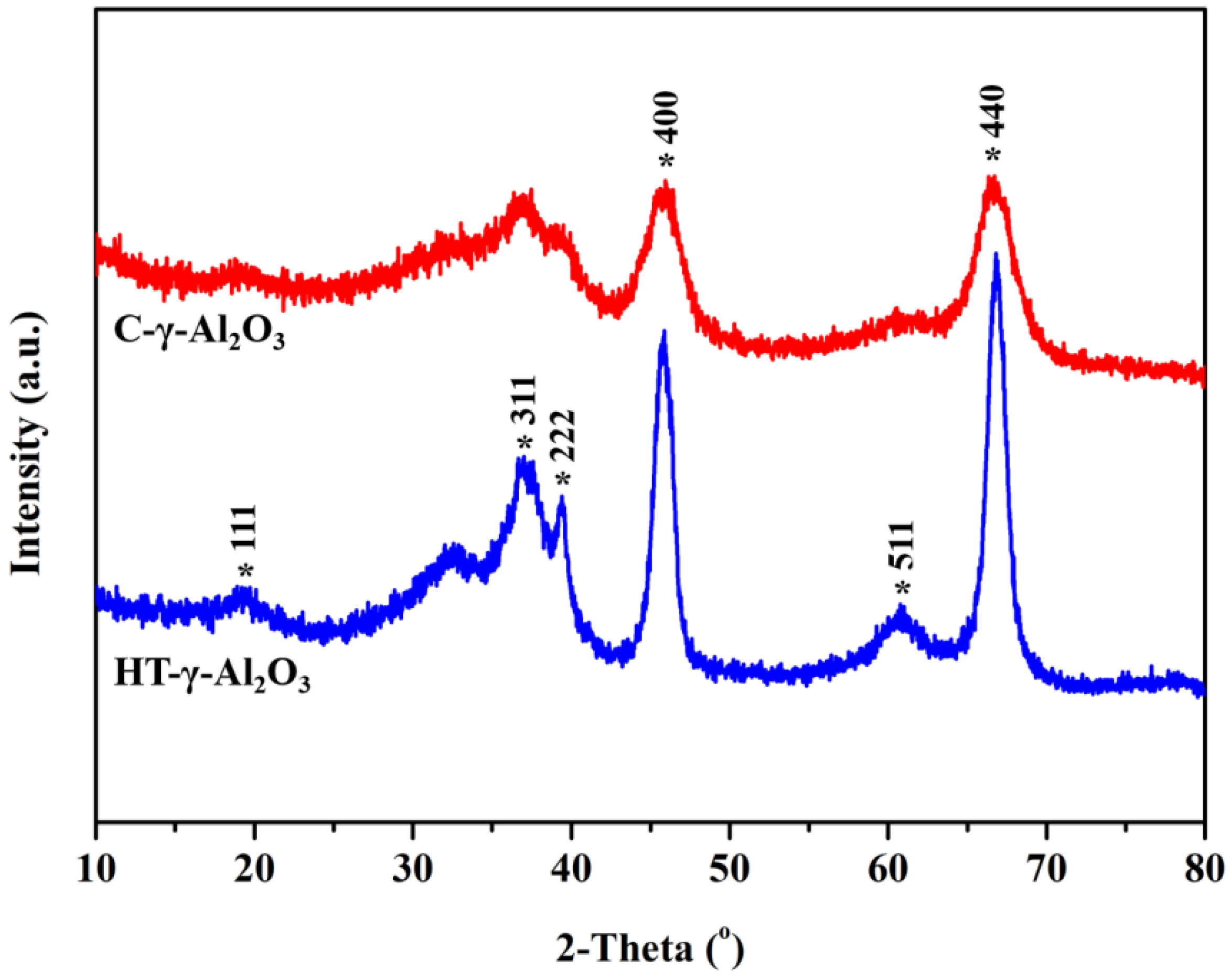
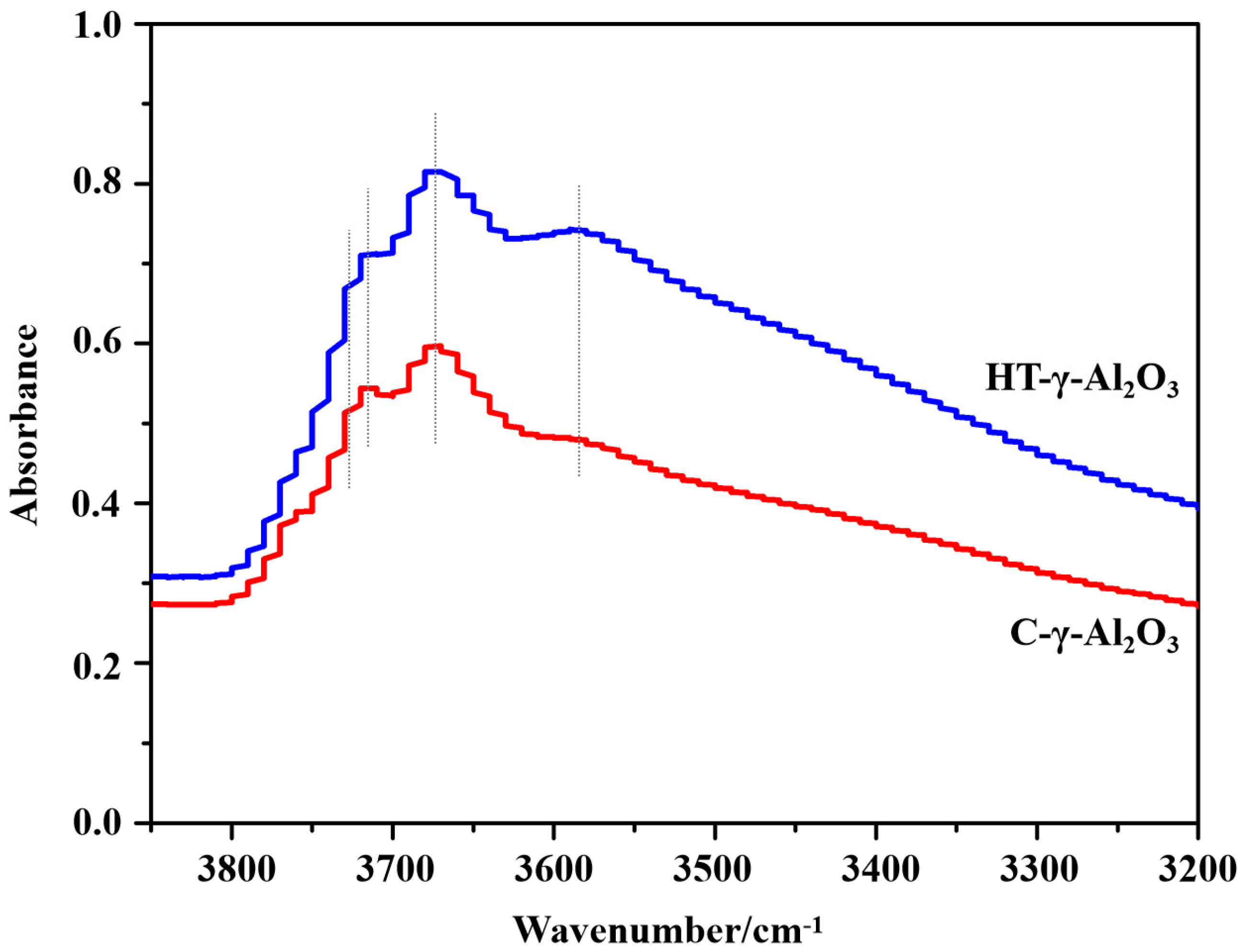
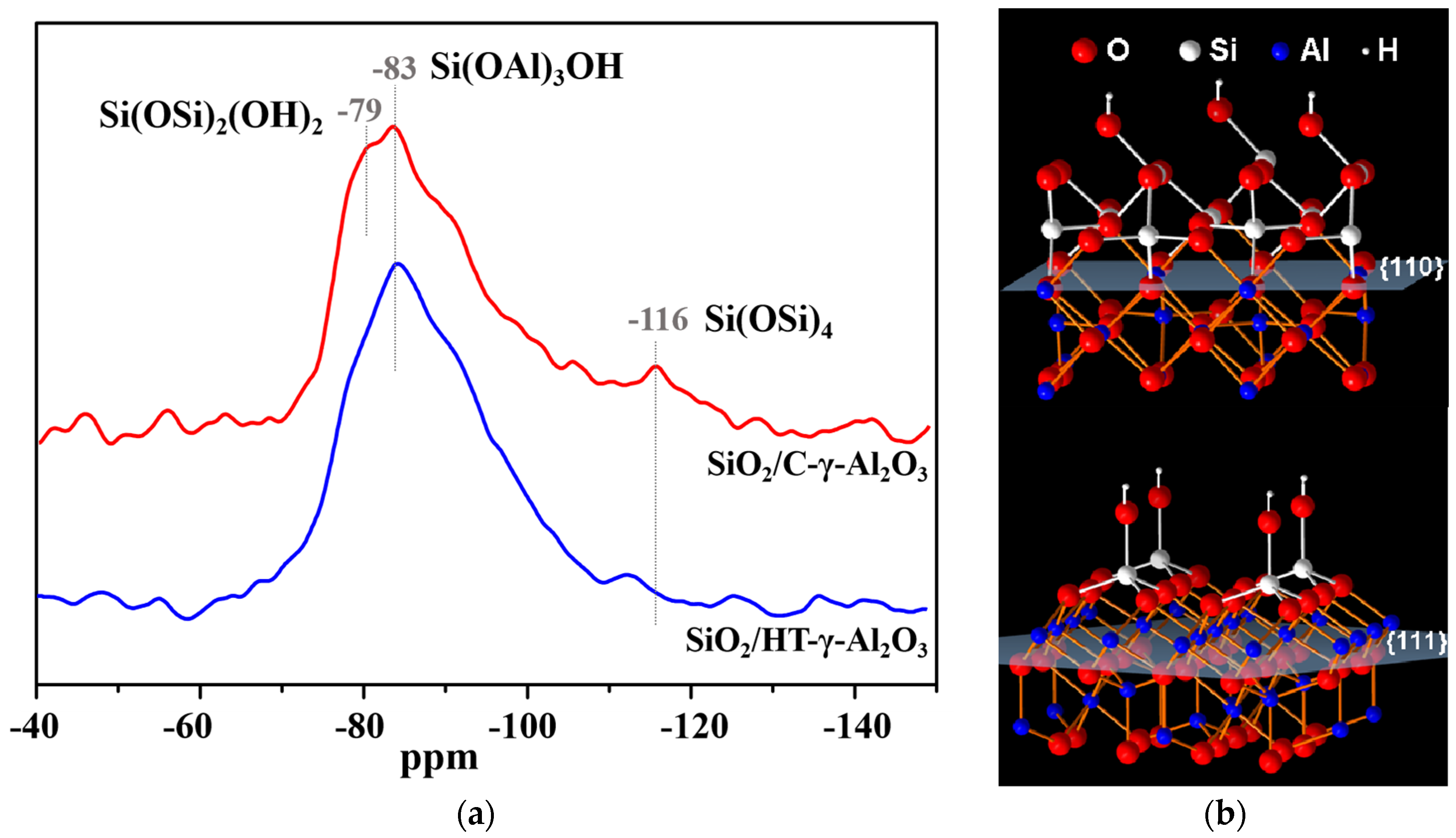


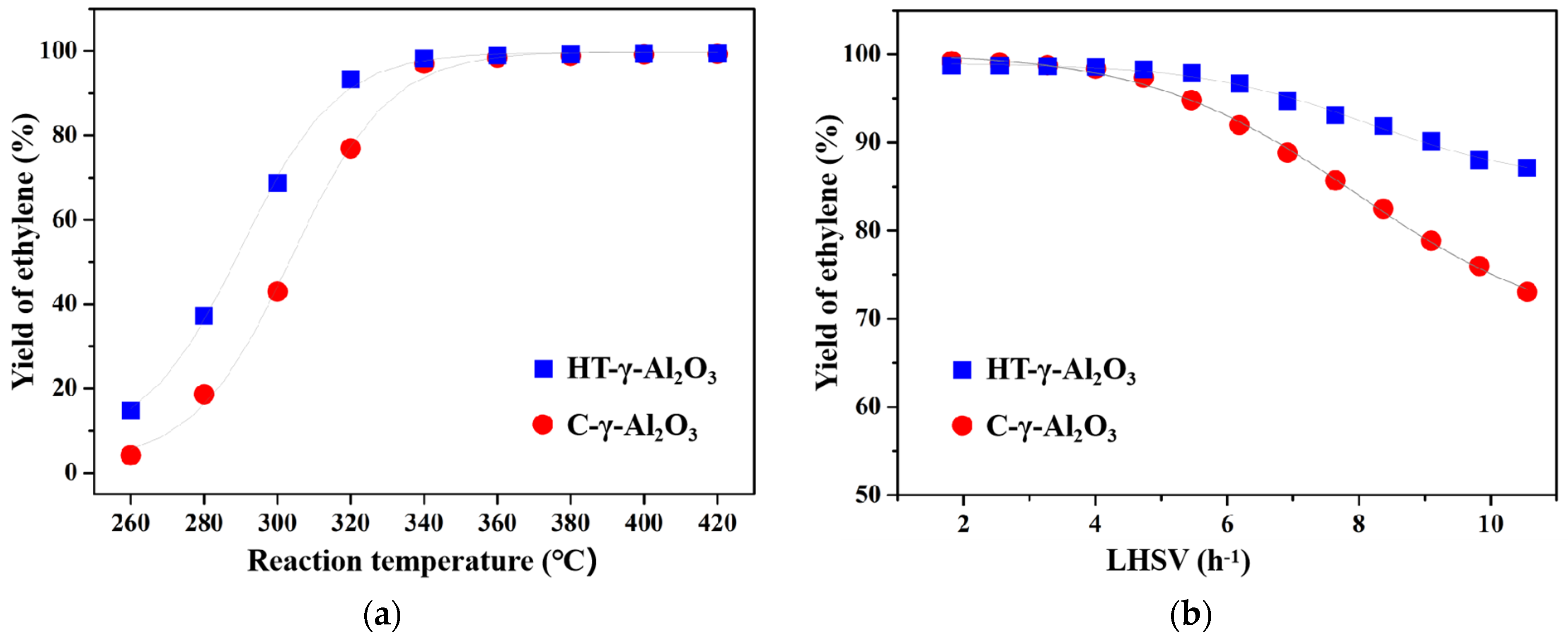
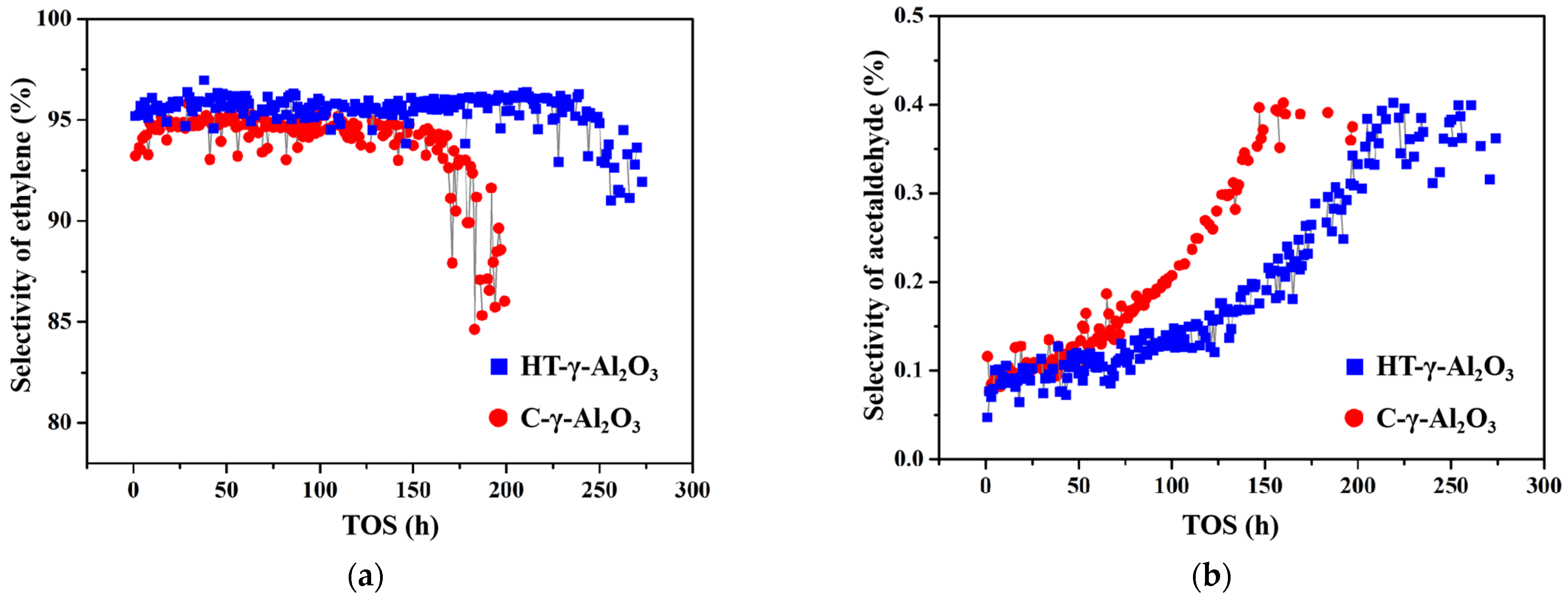
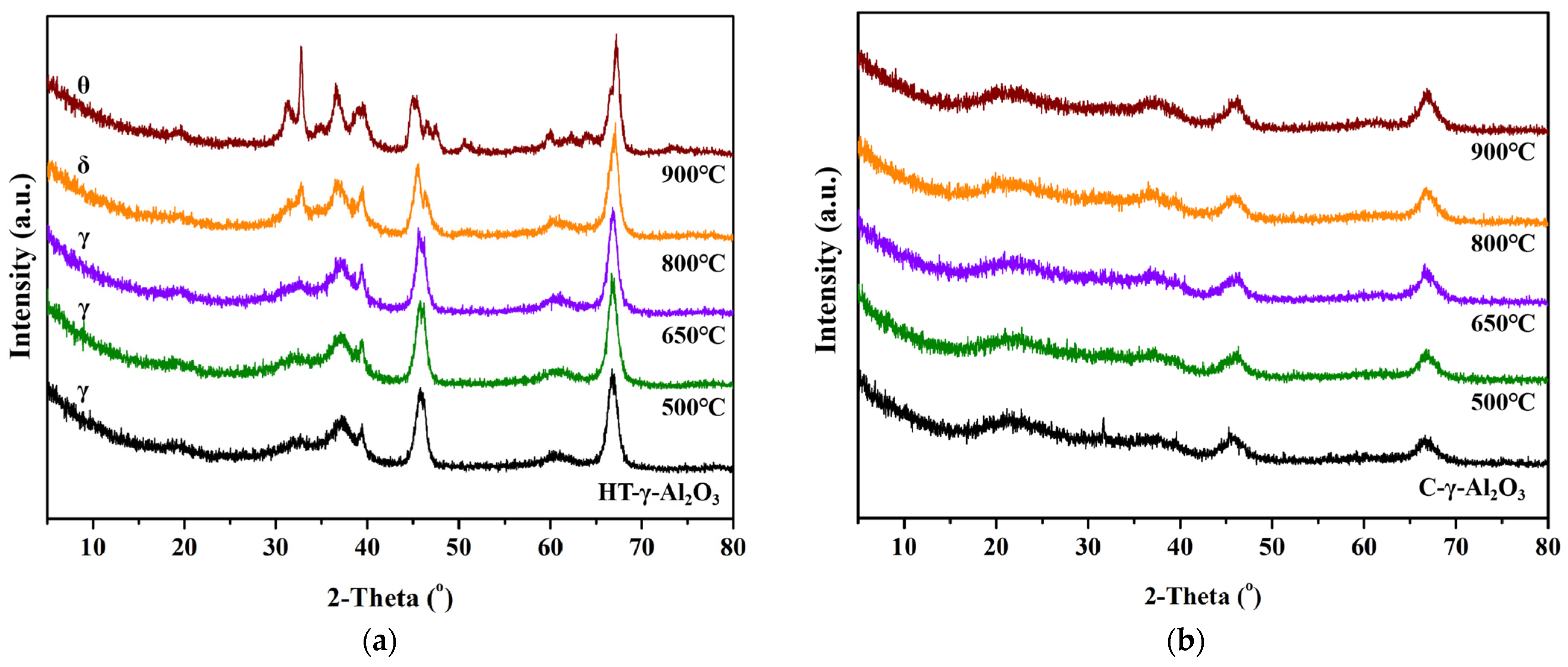

| Sample | Specific Surface Area (m2/g) | Average Pore Diameter (nm) | Pore Volume (m3/g) |
|---|---|---|---|
| C-γ-Al2O3 | 213 | 7.6 | 0.410 |
| HT-γ-Al2O3 | 208 | 8.7 | 0.453 |
| Ethylene | Ethane | Propylene | Acetaldehyde | C4 | Ethanol | Diethyl Ether | Others | |
|---|---|---|---|---|---|---|---|---|
| High conversion | 99.77 | 0.12 | 0.01 | 0.01 | 0.07 | 0.00 | 0.01 | 0.00 |
| Medium conversion | 90.20 | 0.29 | 0.04 | 0.02 | 0.10 | 0.16 | 9.14 | 0.03 |
| HT-γ-Al2O3 | Steam Treatment Temperature/°C | ||||
|---|---|---|---|---|---|
| 500 | 650 | 800 | 900 | ||
| Conversion of ethanol % | 96.0 | 98.2 | 99.9 | 97.2 | 98.0 |
| Selectivity of ethylene % | 94.0 | 96.4 | 99.6 | 95.3 | 95.1 |
| Catalyst | HT-γ-Al2O3 | HT-γ-Al2O3 −650 °C Treated | Industrial Alumina | Silica- Alumina | SiO2- ZrO2 | Phosphomolybdic Acid-PILC | ZSM-5 Nanosheets |
|---|---|---|---|---|---|---|---|
| Reactant ethanol | absolute | 95% | 94% | absolute | 99.5% | absolute | bioethanol |
| Temperature (°C) | 350 | 320 | 400 | 400 | 450 | 300 | 300–350 |
| Conversion% | 100 | 99.9 | 97.5 | 100 | 99.2 | 93.2 | >90 |
| Selectivity of ethylene% | 99.8 | 99.6 | 95.0 | 96.1 | 96.7 | 99.1 | 85% |
| Reference | This work | This work | 24 | 13 | 21 | 22 | 17 |
Disclaimer/Publisher’s Note: The statements, opinions and data contained in all publications are solely those of the individual author(s) and contributor(s) and not of MDPI and/or the editor(s). MDPI and/or the editor(s) disclaim responsibility for any injury to people or property resulting from any ideas, methods, instructions or products referred to in the content. |
© 2023 by the authors. Licensee MDPI, Basel, Switzerland. This article is an open access article distributed under the terms and conditions of the Creative Commons Attribution (CC BY) license (https://creativecommons.org/licenses/by/4.0/).
Share and Cite
Lv, J.; Wang, D.; Peng, L.; Guo, X.; Ding, W.; Yang, W. Ethanol Dehydration to Ethylene over High-Energy Facets Exposed Gamma Alumina. Catalysts 2023, 13, 994. https://doi.org/10.3390/catal13060994
Lv J, Wang D, Peng L, Guo X, Ding W, Yang W. Ethanol Dehydration to Ethylene over High-Energy Facets Exposed Gamma Alumina. Catalysts. 2023; 13(6):994. https://doi.org/10.3390/catal13060994
Chicago/Turabian StyleLv, Jiangang, Di Wang, Luming Peng, Xuefeng Guo, Weiping Ding, and Weimin Yang. 2023. "Ethanol Dehydration to Ethylene over High-Energy Facets Exposed Gamma Alumina" Catalysts 13, no. 6: 994. https://doi.org/10.3390/catal13060994
APA StyleLv, J., Wang, D., Peng, L., Guo, X., Ding, W., & Yang, W. (2023). Ethanol Dehydration to Ethylene over High-Energy Facets Exposed Gamma Alumina. Catalysts, 13(6), 994. https://doi.org/10.3390/catal13060994






